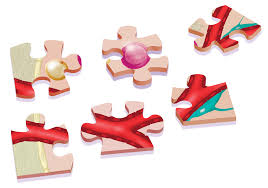Hematopoietic stem cells reside within a bone marrow niche, comprised of heterotypic cellular, structural, physical, and secreted components, all linked in a complex, functional 3-dimensional jigsaw puzzle. Illustration by Madeleine Kersting Flynn, QIMR Berghofer, Herston, Australia.
Hematopoietic stem cells reside within a bone marrow niche, comprised of heterotypic cellular, structural, physical, and secreted components, all linked in a complex, functional 3-dimensional jigsaw puzzle. Illustration by Madeleine Kersting Flynn, QIMR Berghofer, Herston, Australia.
Hematopoiesis is a complex, tightly regulated process of coordinated self-renewal, cell division, and differentiation from hematopoietic stem cells (HSCs) through to terminally differentiated mature blood cells, which adapts to meet needs in both homeostatic and stress contexts. While considerable focus has been placed on the hematopoietic cells themselves, hematopoiesis does not occur in isolation, but is enabled and directed by interactions with nonhematopoietic cell lineages such as the vasculature, mesenchymal stromal cells, neural elements, adipocytes, and osteolineage cells within the bone marrow microenvironment.1,2
The advent of next-generation sequencing has seen the exponential expansion of knowledge of the molecular and clonal complexities of hematopoietic cells in normal and malignant contexts. Until recently, these techniques have been applied to bulk populations of cells, with inherent limitations in sequencing depth and resolution of rare cell populations, especially in admixtures of normal and malignant cells. Single-cell sequencing facilitates interrogation of cells at single-cell resolution allowing dissection of clonal composition and heterogeneity of cell populations without need for computational inferences of subclonality.3
In their recent publication, Dr. Anastasia N. Tikhonova and colleagues use single-cell and bulk mRNA sequencing to delineate spatiotemporal relationships, patterns of prohematopoietic factor production and functional consequences of gene expression changes within the bone marrow microenvironment in mice during steady-state and regenerative hematopoiesis. They couple these techniques with robust identification of cell subpopulations and functional in vitro and in vivo correlative studies.
The authors initially isolated putative cellular HSC niche components such as blood vessels, mesenchymal stromal cells, and osteo-lineage cells to obtain single-cell sequencing data from bone marrow in steady-state conditions. T-distributed stochastic neighbor embedding analyses showed clear separation of the lineage populations. Interestingly, within each lineage, several subpopulations were identified: two endothelial, four perivascular, and three osteolineage subpopulations. Biomarkers were able to distinguish each of these subpopulations, even to the level of arterial vasculature versus sinusoidal capillaries or mesenchymal stromal cells destined for adipogenesis or osteogenic differentiation. The authors were further able to trace differentiation of these latter cell populations along a continuum using relative expression of various differentiation markers. To ascertain interactions between the microenvironment and hematopoietic cells, they profiled expression levels of prohematopoietic factors within individual cells and populations, identifying the specific populations that produce factors with known functions in the cell extrinsic support of HSCs, such as stem cell factor and stromal cell–derived factor 1.
To determine changes during stress hematopoiesis, mice were given a marrow-ablating dose of 5-fluorouracil and the analysis was repeated. In this case, the authors observed an adipocyte-primed cluster not present at steady-state and a global reduction in the osteolineage. They saw an increase in active cycling cells pre-empting bone marrow regeneration, together with changes in expression of prohematopoietic factors, identifying changes in Wnt and Notch signaling. Specifically, Notch ligand, Dll4, expressed only in the vascular cells, was downregulated by chemotherapy treatment. These findings were functionally validated by inducibly deleting Dll4 on mouse niche cells. This resulted in changes within hematopoietic progenitor cell frequencies, specifically leading to myeloid-biased changes and concomitant loss of lymphoid differentiation.
In aggregate, Dr. Tikhonova and colleagues define spatiotemporal transcriptional profiles of distinct subpopulations of the bone marrow niche at single-cell resolution, providing unprecedented detail into the dynamic, complex interactions of the bone marrow microenvironment. These mechanistic insights are elegantly translated using genetically modified mouse models, demonstrating the integral functions of Dll4 in hematopoiesis, particularly after chemotherapy.
In Brief
The study helps to piece together the complex, three-dimensional, living jigsaw puzzle that is the bone marrow HSC niche, highlighting the integral roles of these cells in supporting hematopoiesis in health and disease. The level of detail of the bone marrow microenvironment provides opportunities for discovery of cellular interactions that can be targeted therapeutically in the clinical realm and raises new questions. For example, are there aberrant interactions present that maintain leukemia and leukemic stem cells that can be selectively inhibited using small molecules or antibodies? Can altering prohematopoietic signaling from the microenvironment promote bone marrow regeneration following cytotoxic or immunogenic insults? Can age-related decline in HSC function be stalled or reversed?
Single-cell sequencing is currently limited in the numbers of cells that can be studied (thousands to tens of thousands), but can uniquely provide resolution to detect subtle changes within small subpopulations of cells and will build on bulk sequencing studies. The data and techniques showcased in Dr. Tikhonova and colleagues’ study represent seminal gains in knowledge into the hematopoietic microenvironment and have wide-ranging significance for future studies into normal blood formation, ageing, bone marrow regeneration, and hematopoietic malignancies.
References
Competing Interests
Dr. Ling and Dr. Lane indicated no relevant conflicts of interest.

